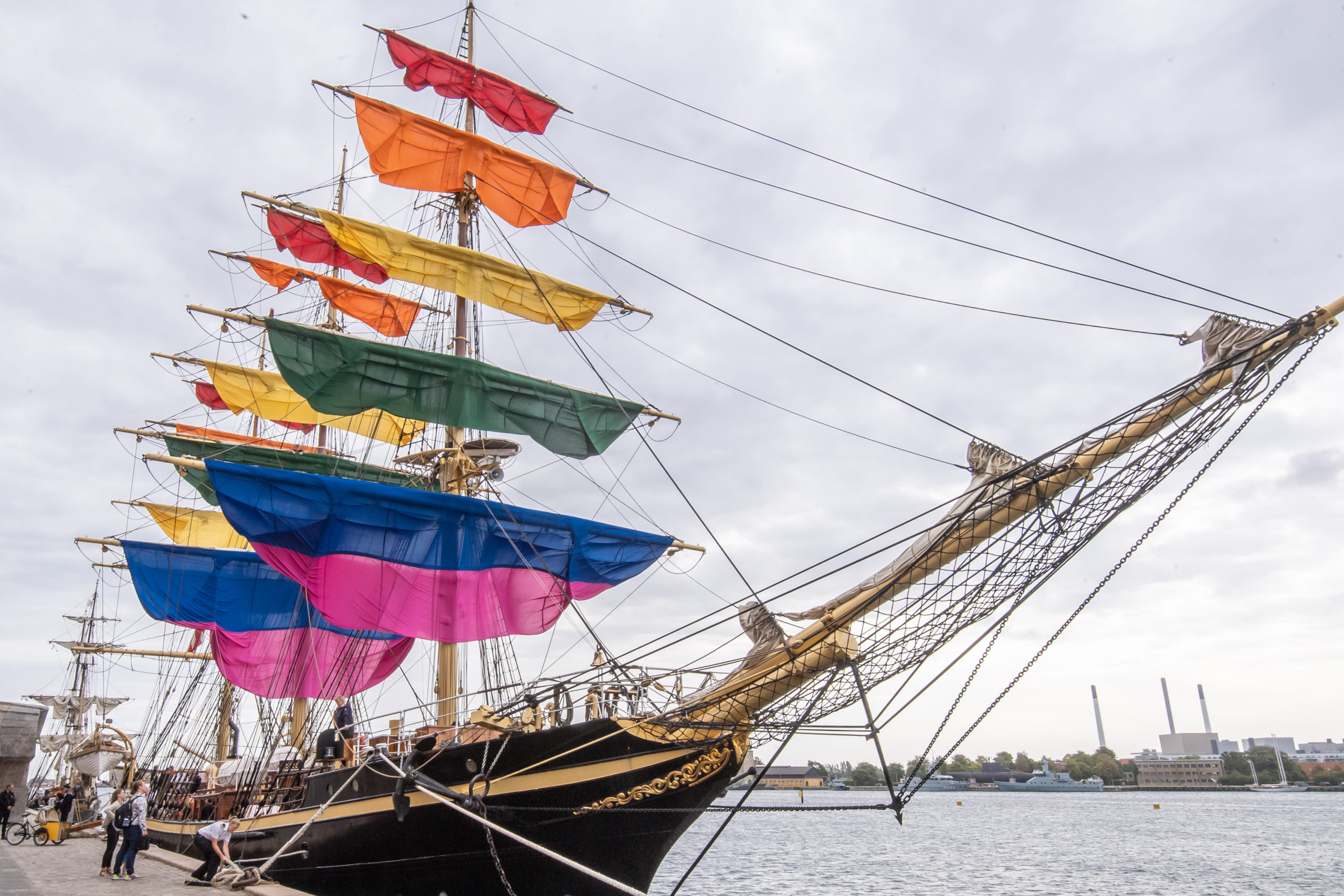
Freedom at sea: Pirates and rainbow flags
Photo: Olav Holten
By Mie Hald
What is the first thing that pops into your mind when hearing the word “pirate”? Marauders who plunder and burn defenseless ships? Bloodthirsty murderers? Blackbeard?
None of these are entirely wrong but like every other aspect of history, it is a bit more nuanced than that. For instance, did you know that homosexual relationships were very common in pirate crews? And that the Captain of the ship often officiated weddings between two of his ’employees’? Did you know that HBO’s Our Flag Means Death might actually be more truthful than you’d think?
Before we begin
This article discusses a period of time, where we didn’t have the terminology to describe different gender identities or sexual orientations – at least not any that has been recorded. It is practically impossible to label human beings that lived hundreds of years ago. So please bear in mind that non-cis pirates existed, but that it’s hard to find concrete names.
At the same time, relationships between two people of the same sex will, in this article, be referred to as “homosexual relationships,” because nuances like bi, pan, and other sexualities aren’t mentioned in these texts.
Sea shanties
When dealing with pirate history, there are some things we need to settle first. First and foremost, it’s impossible to ignore the fact that what we call “pirate history” is very Eurocentric. The GoldenAge of Piracy, for instance, is (according to Wikipedia) only from 1650 to 1730 – less than a hundred years. Additionally, pirates were practically famous amongst the common folk – romanticized heroes escaping society’s strict rules.
Most of the knowledge we have about pirates comes from the book A General History of the Robberies and Murders of the Most Notorious Pyrates (1724), written by an unknown author under the alias Charles Johnson. This book is the inspiration for most of what we in Western culture have taken to heart about pirates – even the way that pirates speak stems from a production of Treasure Island from 1950, and is actually an exaggeration of a British regional dialect.
Johnson barely made use of any source material and made up a lot of the content of his book. He only focused on two female pirates, Anne Bonny and Mary Read, but a wide range of male captains. In his book Under the Black Flag, historian, David Cordingly, states that some of Johnson’s stories are based on truths; some of the pirates that Johnson wrote about were actually his contemporaries, and he also made use of newspapers and eye-witnesses as sources.
Therefore, mainstream pirates are just as correct as mainstream Vikings – which you can read more about in the previous issue of HeartCore!
However, queer pirates are largely disputed..
Matelotage: Marriage between sailors
Again, we need to set one thing straight: People have always entered into relationships across (and in spite of) gender, either by nature or need. You see instances of this today in places where genders aren’t ‘mixed,’ e.g. in jails, or dating back a few decades, the army. The involved parties are seeking out available options, though they might not make that choice if they had fewer limitations.
This has also been the case on ships. For some time, women were not welcome on ships, and for that same reason, there were a lot of crews solely consisting of men (with the lack of gender-understanding at that time) on the sea, having no one but each other for months at the time.
This doesn’t mean that there weren’t any flourishing homosexual relationships – life at sea offered them freedom for Europe’s strict ideologies. In The Golden Age of Piracy, homosexual acts could result in flogging or hanging.
To be a couple at sea was not unheard of – not even if you had a family ashore. It meant security and insurance, but also comfort and safety. It was so common that there was a word for it on pirate ships; matelotage.
Matelotage is French for “seamanship”, and it was a civil union between two people of the same gender. This practice was especially common in the 17th and 18th centuries, and the individuals in the relationship would split their incomes and inherit each other’s earthly belongings in case of death.
Basically, it was marriage between sailors – often with everything a marriage usually entails, even if the initial intentions were non-romantic. But then again, that wasn’t necessarily the norm for most marriages at that time anyway. The crews respected the matelotage union in the same way that they would respect a marriage on land.
The Buccaneers
Okay, so you’re not impressed by a single word for homosexual pirate marriage? How about an entire homosexual pirate society?
We’ll find that with the buccaneers. The buccaneers cropped up on the Caribbean island, Hispaniola, which is present-day Haiti and Dominican Republic. Around 1605, Spain had abandoned their colonies on the island, and it became a hideout for escaped slaves, deserters, and sailors – anyone who would have good reason to hide.
The population was primarily made up of men and for that reason, numerous homosexual relationships developed. They made a living by selling pelts and meats to by-passing ships and built a society that actually (on paper) is very much like an early version of the well-fare state, complete with health insurance and similar modern public institutions.
The Spanish Inquisition had them fleeing to the considerably smaller island, Tortuga, which had fewer resources and opportunities. Soon, most of the population turned to piracy in order to survive. A society of homosexual pirates was born.
Skulls or Rainbow Flags
The tedious historian might argue that homosexual relationships were a result of need rather than want. But when the French governor, Jean Le Vasseur, shipped 1,650 female sex workers and small-scale criminals from Paris to Tortuga, in the hopes of pushing the population back into their “rightful place,” the buccaneers continued their partnerships or expanded them into bisexual, polyamorous relationships.
Who knew that people didn’t like being constrained by societal norms after they’d built a nice life for themselves with their best friend and life partner?
Even in the navy, where relations such as these were strictly forbidden, many captains turned a blind eye to what their crew was up to; intimate relationships reduced tensions and stress and strengthened the bond between the men.
It was actually one of the ways the pirate crews recruited new members from the ships they attacked. You can’t break the law if there is no law to break!
You can read about homosexual relationships between pirates in books, such as Antonio Pigafetta’s journal, The Sodomy Trial. A contemporary French historian even wrote: “They never engaged in combat without embracing each other as a sign of reconciliation. At such times one might see them thumping their chests, as if they wanted to arouse some remorse in their hearts, something they had become scarcely capable of.”
Pirates sailed under a metaphorical rainbow flag for centuries.
The Chinese Pirate Queen
Throughout history, it’s been considered bad luck to have women aboard ships – one of the many superstitions entertained by sailors for generations. But in spite of what the norm-driven history lesson wants you to believe, women did not sit idle with their hands in their laps until they finally had enough in the beginning of the 1900s.
Among the most famous female pirates is Zheng Yi Sao (鄭一嫂), also known as Madame Ching, who was a pirate that controlled the South China Sea from 1801 to 1810 – and yes, if she boarded your ship, it definitely meant bad luck. Madame Ching is deemed the most powerful pirate ever, and she lived from 1775 to 1844.
Powerful how, you might ask? Well, powerful in the sense that she had a modest amount of 400 ships, and between 40 and 60,000 pirates under her command, and she’s one of the only pirates – if not the only pirate – to ever retire and live out the remainder of her days in wealth, peace, and quiet.
Stay with me; it’s about to get complicated.
Madame Ching first came into power through her marriage to the pirate Chen Yi in 1801, and not much is known about her life before that moment, apart from the fact that she was a sex worker. Cheng Yi had chosen his adopted son Cheung Po Tsai (who Cheng Yi adopted as an adult because he had proven himself a capable pirate) as his sole heir, even though he had two children with Madame Ching. Tsai started out as Cheng Yi’s lover and later became Madame Ching’s husband after Cheng Yi, being a very capable sailor, tragically sailed head first into a storm and died.
Women at sea
Two female pirates that everyone who’s shown an interest in the subject will know, are Anne Bonny and Mary Read. They are two of the most infamous female pirates and they both spent a substantial amount of their lives disguised as men.
Ever since childhood, Mary used the name Mark, but according to the texts written about them, they didn’t refer to each other as men – for that reason it’s hard to discern whether Anne or Mary was on a different part of the gender spectrum than cis women. For the purpose of this article, they’ll both be referred to with she/her pronouns, as those were the pronouns they used for each other, according to historical sources.
Anne Bonny was born as an illegitimate child and dressed as a boy and named Andy so that she could work without being found out. While Anne was sailing with John Rackham (aka Calico Jack), she met Mary Read.
Mary was sweet on the Captain’s lover with the mysteriously smooth face, and it’s alluded to in A General History of the Robberies and Murders of the Most Notorious Pyrates, that the both of them thought that the other one was a man.
The two of them hooked up – just not with each other. They each began a relationship with Captain Rackham. The poly pirates are at it again!
On the 15th of November 1720, Rackham’s crew celebrated a victory. Anne Bonny and Mary Read stayed off the rum, because even today, few women would feel comfortable getting hammered surrounded by dozens of lawless men. While the rest of the crew was plastered, the ship was attacked by the pirate-hunter, Jonathan Barnet.
Bonny and Read fought against them, but the fight was short. The crew was taken away and sentenced to death, and Anne’s last words to Rackham were as follows: “Had you fought like a man, you need not have been hang’d like a dog.”
Both Anne Bonny and Mary Read got out of an immediate death sentence, as they were both allegedly pregnant. However, Read soon after died in jail from a fever, but Anne escaped. What became of her after is still unknown. Maybe she lived out the rest of her days in solitary bliss, or maybe she returned to the sea as Andy.
Explore Pirate History
The hit show Our Flag Means Death from HBO is one of the most realistic pirate shows I’ve ever seen because it deals with aspects of the pirate life that are often hidden away. It was a time where Blackbeard sailed with The Gentleman Pirate, but no one quite knows why the fearsome pirate would want to travel with a British aristocrat. So they might as well have been lovers!
There are so many things to learn about pirates, and it is completely impossible to fit all of it in a 2,000-word article – even when ‘limited’ to the rainbow flag. And for that reason, I’d encourage you to continue researching on your own.
The sources used for this article are as follows:



